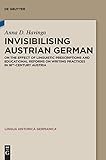Invisibilising Austrian German : On the effect of linguistic prescriptions and educational reforms on writing practices in 18th-century Austria / Anna Dorothea Havinga.
Material type: TextSeries: Lingua Historica Germanica : Studien und Quellen zur Geschichte der deutschen Sprache und Literatur ; 18Publisher: Berlin ; Boston : De Gruyter, [2018]Copyright date: ©2018Description: 1 online resource (XVI, 256 p.) : 59 TabellenContent type:
TextSeries: Lingua Historica Germanica : Studien und Quellen zur Geschichte der deutschen Sprache und Literatur ; 18Publisher: Berlin ; Boston : De Gruyter, [2018]Copyright date: ©2018Description: 1 online resource (XVI, 256 p.) : 59 TabellenContent type: - 9783110546293
- 9783110546491
- 9783110547047
- 306.442/310436
- online - DeGruyter
- Issued also in print.
| Item type | Current library | Call number | URL | Status | Notes | Barcode | |
|---|---|---|---|---|---|---|---|
 eBook
eBook
|
Biblioteca "Angelicum" Pont. Univ. S.Tommaso d'Aquino Nuvola online | online - DeGruyter (Browse shelf(Opens below)) | Online access | Not for loan (Accesso limitato) | Accesso per gli utenti autorizzati / Access for authorized users | (dgr)9783110547047 |
Frontmatter -- Acknowledgements -- Contents -- List of Figures -- List of Tables -- Abbreviations and notes on presentation -- 1. Introduction -- 2. Language, Enlightenment and education in 18th-century Austria -- 3. Grammarians’ norm prescriptions -- 4. The implementation of the language reform -- 5. Conclusion -- Appendix -- Bibliography -- Index
restricted access online access with authorization star
http://purl.org/coar/access_right/c_16ec
This book provides an insight into the standardisation process of German in eighteenth-century Austria. It describes how norms prescribed by grammarians were actually implemented via a school reform carried out by educationalist Johann Ignaz Felbiger on the order of Empress Maria Theresa. Quantitative and qualitative analyses were undertaken of certain Upper German features (e-apocope, the absence of the prefix ge- and the ending -t in past participles, and variants of the verb form sind) in reading primers, issues of the Wienerisches Diarium / Wiener Zeitung and petitionary letters. These reveal how such variants became increasingly 'invisible' in writing. This process of 'invisibilisation', i.e. a process of stigmatization which prevents the use of certain varieties and variants in writing, can be attributed to a number of factors: Empress Maria Theresa's appeal for a language reform, the normative work by eighteenth-century grammarians, the implementation of educational reforms, and the early introduction of East Central German variants in newspaper issues.
Issued also in print.
Mode of access: Internet via World Wide Web.
In English.
Description based on online resource; title from PDF title page (publisher's Web site, viewed 25. Jun 2024)


